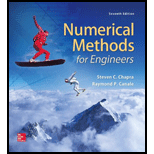
Numerical Methods for Engineers
7th Edition
ISBN: 9780073397924
Author: Steven C. Chapra Dr., Raymond P. Canale
Publisher: McGraw-Hill Education
expand_more
expand_more
format_list_bulleted
Concept explainers
Textbook Question
Chapter 18, Problem 3P
Fit a third-order Newton's interpolating polynomial to estimate log 10 using the data from Prob. 18.1.
Expert Solution & Answer
Want to see the full answer?
Check out a sample textbook solution
Students have asked these similar questions
Use mathematical induction to prove the following statement: For all natural numbers n, 5 divides 6^n - 1 (show every step in detail)
Use mathematical induction to prove the following statement: For all natural numbers n, 5 divides 6^n - 1
the set of all preimages of 2 is
Chapter 18 Solutions
Numerical Methods for Engineers
Ch. 18 - 18.1 Estimate the common logarithm of 10 using...Ch. 18 - 18.2 Fit a second-order Newton’s interpolating...Ch. 18 - 18.3 Fit a third-order Newton’s interpolating...Ch. 18 - Repeat Probs. 18.1 through 18.3 using the Lagrange...Ch. 18 - 18.5 Given these...Ch. 18 - 18.6 Given these data
x 1 2 3 5 7 8
...Ch. 18 - Repeat Prob. 18.6 using Lagrange polynomials of...Ch. 18 - 18.8 The following data come from a table that was...Ch. 18 - 18.9 Use Newton’s interpolating polynomial to...Ch. 18 - Use Newtons interpolating polynomial to determine...
Ch. 18 - 18.11 Employ inverse interpolation using a cubic...Ch. 18 - 18.12 Employ inverse interpolation to determine...Ch. 18 - 18.13 Develop quadratic splines for the first five...Ch. 18 - 18.14 Develop cubic splines for the data in Prob....Ch. 18 - Determine the coefficients of the parabola that...Ch. 18 - Determine the coefficients of the cubic equation...Ch. 18 - 18.17 Develop, debug, and test a program in either...Ch. 18 - 18.18 Test the program you developed in Prob....Ch. 18 - 18.19 Use the program you developed in Prob. 18.17...Ch. 18 - Use the program you developed in Prob. 18.17 to...Ch. 18 - Develop, debug, and test a program in either a...Ch. 18 - 18.22 A useful application of Lagrange...Ch. 18 - Develop, debug, and test a program in either a...Ch. 18 - Use the software developed in Prob. 18.23 to fit...Ch. 18 - Use the portion of the given steam table for...Ch. 18 - The following is the built-in humps function that...Ch. 18 - 18.28 The following data define the sea-level...Ch. 18 - 18.29 Generate eight equally-spaced points from...Ch. 18 - 18.30 Temperatures are measured at various points...
Additional Math Textbook Solutions
Find more solutions based on key concepts
In Exercises 5-36, express all probabilities as fractions.
23. Combination Lock The typical combination lock us...
Elementary Statistics
1. How much money is Joe earning when he’s 30?
Pathways To Math Literacy (looseleaf)
For Problems 23-28, write in simpler form, as in Example 4. logbFG
Finite Mathematics for Business, Economics, Life Sciences and Social Sciences
1. How is a sample related to a population?
Elementary Statistics: Picturing the World (7th Edition)
True or False The quotient of two polynomial expressions is a rational expression, (p. A35)
Precalculus
23. A plant nursery sells two sizes of oak trees to landscapers. Large trees cost the nursery $120 from the gro...
College Algebra (Collegiate Math)
Knowledge Booster
Learn more about
Need a deep-dive on the concept behind this application? Look no further. Learn more about this topic, advanced-math and related others by exploring similar questions and additional content below.Similar questions
- Which diagram(s) represent the following relationships An injective function from A to B? A surjective function from A to B? An injective function from B to A? A surjective function from B to A?arrow_forwardDetermine if each statement is true or false. If the statement is false, provide a brief explanation: a) There exists x = R such that √x2 = -x. b) Let A = {x = ZIx = 1 (mod 3)} and B = {x = ZIx is odd}. Then A and B are disjoint. c) Let A and B be subsets of a universal set U. If x = A and x/ € A - B,then x = An B.| E d) Let f : RR be defined by f (x) = 1 x + 2 1. Then f is surjective.arrow_forwardWrite the negation of the definition of an injective functionarrow_forward
- Let U= {0, 1, 2, 3, 4, 5, 6, 7, 8, 9}, A = {xeU Ix is a multiple of 3}, and B = {x = UIx = 0 (mod 2)}. Use the roster method to list all elements in each of the following sets: a) A, b) B, c) A u B, d) B – A, e) A^cn Barrow_forwardThe function f is; Injective (only), Surjective (only), Bijective, or none? show workarrow_forwardFor each a Є Z, if a ‡0 (mod 3), then a² = 1 (mod 3).arrow_forward
- find: f(3)=? , and the set of all preimages of 2 is ?arrow_forwardConstruct tables showing the values of alI the Dirichlet characters mod k fork = 8,9, and 10. (please show me result in a table and the equation in mathematical format.)arrow_forwardExample: For what odd primes p is 11 a quadratic residue modulo p? Solution: This is really asking "when is (11 | p) =1?" First, 11 = 3 (mod 4). To use LQR, consider two cases p = 1 or 3 (mod 4): p=1 We have 1 = (11 | p) = (p | 11), so p is a quadratic residue modulo 11. By brute force: 121, 224, 3² = 9, 4² = 5, 5² = 3 (mod 11) so the quadratic residues mod 11 are 1,3,4,5,9. Using CRT for p = 1 (mod 4) & p = 1,3,4,5,9 (mod 11). p = 1 (mod 4) & p = 1 (mod 11 gives p 1 (mod 44). p = 1 (mod 4) & p = 3 (mod 11) gives p25 (mod 44). p = 1 (mod 4) & p = 4 (mod 11) gives p=37 (mod 44). p = 1 (mod 4) & p = 5 (mod 11) gives p 5 (mod 44). p = 1 (mod 4) & p=9 (mod 11) gives p 9 (mod 44). So p =1,5,9,25,37 (mod 44).arrow_forward
- how to construct the following same table?arrow_forwardplease work out more details give the solution.arrow_forwardBurger Dome sells hamburgers, cheeseburgers, french fries, soft drinks, and milk shakes, as well as a limited number of specialty items and dessert selections. Although Burger Dome would like to serve each customer immediately, at times more customers arrive than can be handled by the Burger Dome food service staff. Thus, customers wait in line to place and receive their orders. Burger Dome analyzed data on customer arrivals and concluded that the arrival rate is 30 customers per hour. Burger Dome also studied the order-filling process and found that a single employee can process an average of 44 customer orders per hour. Burger Dome is concerned that the methods currently used to serve customers are resulting in excessive waiting times and a possible loss of sales. Management wants to conduct a waiting line study to help determine the best approach to reduce waiting times and improve service. Suppose Burger Dome establishes two servers but arranges the restaurant layout so that an…arrow_forward
arrow_back_ios
SEE MORE QUESTIONS
arrow_forward_ios
Recommended textbooks for you
- Algebra & Trigonometry with Analytic GeometryAlgebraISBN:9781133382119Author:SwokowskiPublisher:Cengage
 Elementary Linear Algebra (MindTap Course List)AlgebraISBN:9781305658004Author:Ron LarsonPublisher:Cengage Learning
Elementary Linear Algebra (MindTap Course List)AlgebraISBN:9781305658004Author:Ron LarsonPublisher:Cengage Learning
 Linear Algebra: A Modern IntroductionAlgebraISBN:9781285463247Author:David PoolePublisher:Cengage Learning
Linear Algebra: A Modern IntroductionAlgebraISBN:9781285463247Author:David PoolePublisher:Cengage Learning Functions and Change: A Modeling Approach to Coll...AlgebraISBN:9781337111348Author:Bruce Crauder, Benny Evans, Alan NoellPublisher:Cengage Learning
Functions and Change: A Modeling Approach to Coll...AlgebraISBN:9781337111348Author:Bruce Crauder, Benny Evans, Alan NoellPublisher:Cengage Learning Intermediate AlgebraAlgebraISBN:9781285195728Author:Jerome E. Kaufmann, Karen L. SchwittersPublisher:Cengage Learning
Intermediate AlgebraAlgebraISBN:9781285195728Author:Jerome E. Kaufmann, Karen L. SchwittersPublisher:Cengage Learning

Algebra & Trigonometry with Analytic Geometry
Algebra
ISBN:9781133382119
Author:Swokowski
Publisher:Cengage

Elementary Linear Algebra (MindTap Course List)
Algebra
ISBN:9781305658004
Author:Ron Larson
Publisher:Cengage Learning


Linear Algebra: A Modern Introduction
Algebra
ISBN:9781285463247
Author:David Poole
Publisher:Cengage Learning

Functions and Change: A Modeling Approach to Coll...
Algebra
ISBN:9781337111348
Author:Bruce Crauder, Benny Evans, Alan Noell
Publisher:Cengage Learning

Intermediate Algebra
Algebra
ISBN:9781285195728
Author:Jerome E. Kaufmann, Karen L. Schwitters
Publisher:Cengage Learning
Continuous Probability Distributions - Basic Introduction; Author: The Organic Chemistry Tutor;https://www.youtube.com/watch?v=QxqxdQ_g2uw;License: Standard YouTube License, CC-BY
Probability Density Function (p.d.f.) Finding k (Part 1) | ExamSolutions; Author: ExamSolutions;https://www.youtube.com/watch?v=RsuS2ehsTDM;License: Standard YouTube License, CC-BY
Find the value of k so that the Function is a Probability Density Function; Author: The Math Sorcerer;https://www.youtube.com/watch?v=QqoCZWrVnbA;License: Standard Youtube License